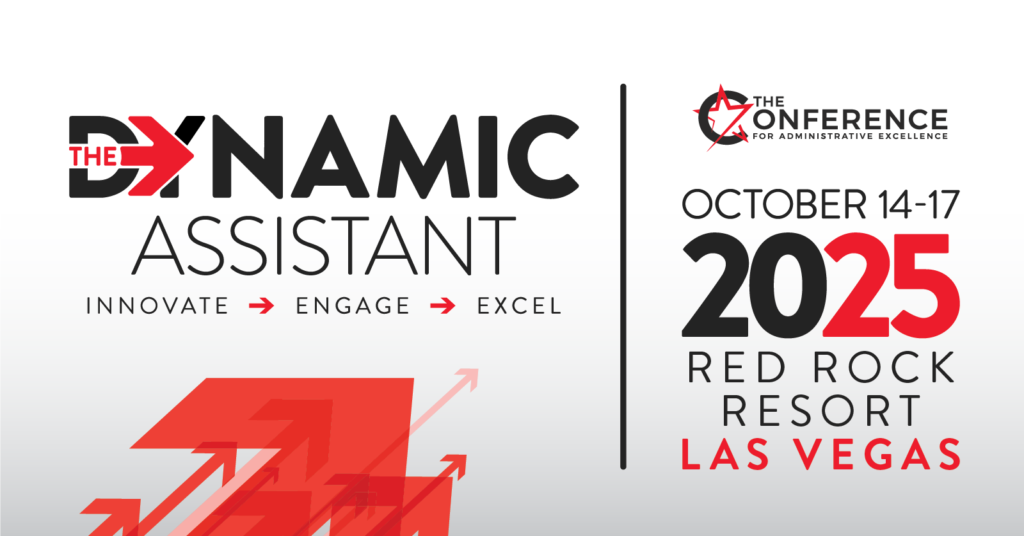What Is an Administrative Assistant Strategic Partnership?
Despite their critical role, the administrative profession is often undervalued and misunderstood.
Many people underestimate the skill, organization, and expertise required to excel in these positions. Instead, they view the work as menial, routine, or less impactful than other roles.
This perception overlooks that administrative professionals make crucial contributions to a company’s productivity and success.
In my recent interview with Forbes, I share what I’ve learned over decades of working with executives and training thousands of assistants: when leaders recognize and support the efforts of administrative professionals, and foster a workplace culture that values every individual’s role in achieving collective goals, everyone thrives.
A strong executive – administrative assistant strategic partnership produces synergy that contributes exponentially to organizational success.
Administrative and executive assistants are, in fact, the backbone of a well-functioning organization. They are strategic partners who ensure operations run seamlessly.
Without them, things very often simply fall apart. From managing complex schedules and coordinating high-level meetings to streamlining communication across departments, their work directly impacts the efficiency and productivity of their leader and the company as a whole.
Assistants possess a unique blend of organizational prowess, adaptability, and problem-solving skills. This powerful arsenal enables them to anticipate needs and solve issues before they even arise. Far from being routine, their role is integral to achieving organizational goals, supporting leadership, and fostering a collaborative and efficient workplace environment.
Mindset Shifts for Strategic Collaboration
To demystify misconceptions about their work, assistants can take proactive steps to elevate their role within their organization. This empowers them to shift the narrative about their position from merely supportive to recognizing it as pivotal.
Elevating their position from “just an admin” to a strategic partner solidifies their crucial impact on their leader’s success and the organization’s operations.
One of the most important steps in this evolution is a mindset shift. Assistants must move beyond traditional perceptions of their role and begin to see and present themselves as advisors, collaborators, and leaders in their own right. This shift in perspective transforms the way others perceive your contributions, and more importantly, how you perceive your own potential.
When you embrace the role of strategic partner, you stop waiting for permission and start taking initiative. You look beyond daily tasks and begin aligning your actions with broader business goals. You focus not only on what you do, but on why it matters.
This blog will explore practical strategies to help assistants elevate their role and strive toward the ultimate goal of creating a strategic partnership with their executive. When assistants position themselves as proactive leaders and problem solvers, they create a more accurate and empowered image of their critical role.
Why Elevating the Role Matters
Being seen as a strategic, indispensable professional rather than simply a support role opens doors to new opportunities.
Leaders are more likely to trust and rely on you for key projects when they see you as a partner. Organizations, too, benefit from administrative professionals capable of driving operational efficiency and contributing to strategic decisions.
Shifting the perception of your role enriches your career beyond your current position and proves the immense value you bring to your team.
Benefits of Strategic Admin–Executive Synergy
A strong partnership with your leader fosters mutual respect and paves the way for collaboration.
When you evolve as a team and work together strategically, you:
- Strengthen communication and trust, leading to enhanced collaboration, which boosts productivity and effectiveness.
- Gain access to higher-level responsibilities for professional development and career growth.
- Build influence across teams and departments for greater organizational efficiency.
- Ensure alignment with your leader’s goals, to amplify both of you and your contributions to the organization.

How to Build a Strategic Partnership with Your Leader
Creating a meaningful and impactful relationship with your leader goes beyond simply fulfilling daily tasks. I’ll walk you through six key steps and top skills to elevate your role and build a partnership that adds value, drives results, and fosters mutual trust.
From understanding your leader’s goals to aligning your efforts with the bigger picture, these actionable strategies will help you make a lasting impact and position yourself as an essential part of the team’s success:
1. Master Advanced Skills
To stand out, focus on sharpening and expanding your skills. Elevating your expertise will demonstrate your commitment to professional development and readiness for greater responsibility.
Invest in Your Professional Development
Make continuous learning a priority. Attend industry conferences, enroll in relevant courses, participate in webinars, and pursue certifications to develop expertise in areas such as project management, scheduling software, or leadership.
Develop Financial and Data Literacy
Understanding financial reports, budgets, and key performance indicators empowers you to participate in high-level discussions with credibility. Stand-out assistants strive to become proficient in analyzing data, enabling them to provide insights that support informed decision-making.
Become Tech-Savvy
Leverage advanced software and tools to streamline workflows and tackle complex tasks. Explore technologies such as collaboration platforms, data analytics tools, or emerging industry software to stay ahead.
Focus Resources
Check out The Role of Strategic Partner for more detailed guidance on mastering the skills to align with your leader.
2. Think and Act Strategically
Strategic thinking is one of the most valued skills in today’s workplace. By anticipating challenges, spotting opportunities, and focusing on a big-picture perspective, you can position yourself as an invaluable partner.
Understand Your Leader’s Vision
What are your leader’s long-term goals? What’s driving their priorities? By having a clear understanding, you can align your actions with their vision and provide proactive support.
Anticipate Needs and Challenges
Be two steps ahead. Is there an upcoming deadline that requires adjustments to the schedule? Is a key meeting missing its materials? Anticipate these gaps and resolve them proactively.
Add Tactical Value
You’re not just executing tasks – you’re connecting them to larger objectives. For example, if you’re planning a departmental meeting, consider how it feeds into overarching team goals and communicate this alignment to your executive.
For more specific insights on this skill, check out Cultivating a Strategic Mindset as an Admin Assistant.
3. Build Leadership and Influence
Administrative professionals are uniquely positioned to influence teams from all levels of the organization. Leadership, even when it doesn’t come with a title, is about earning respect and driving positive change.
Lead Through Communication
Be clear, concise, and persuasive in your communication. Understand the needs of different audiences, from executives to front-line staff, and tailor your messaging to resonate with them.
Strengthen Relationships Across Teams
Build strong connections within and outside your department. By being a trusted liaison, you can facilitate collaboration, resolve conflicts, and keep team dynamics running smoothly.
Stay Calm Under Pressure
When challenges arise, colleagues and leaders will look to you for composure. Being someone who remains steady and solutions-oriented cements your reputation as an effective leader.
Explore 6 Ways for Assistants to Gain Respect to identify more strategies for building influence and stepping into your leadership role.
4. Demonstrate Proactivity
Being proactive is one of the most essential elements of a trusted partner. Prove to your leader you’ve got their back by taking the initiative in your work.
Solve Problems Before They Arise
Identify potential obstacles and eliminate them before they escalate. For example, ensure necessary approvals or resources are secured well in advance of a critical project.
Suggest Ideas and Improvements
Don’t shy away from contributing innovative solutions. Whether it’s streamlining a process or proposing a new system, proactive suggestions show your dedication to the organization’s success.
Volunteer for High-Visibility Projects
Taking on challenging assignments outside your job description highlights your initiative and ability to contribute at a more strategic level.
5. Practice Emotional Intelligence
Navigating the complexities of work relationships requires emotional intelligence (EQ). Strong EQ helps you manage interpersonal dynamics and strengthen trust with your leader and colleagues.
Know Yourself
Identify your own strengths, weaknesses, and triggers. Self-awareness helps you maintain professionalism and engagement in all situations.
Read the Room
Pick up on the emotions and expectations of others. This can be especially useful in managing tense situations or gauging your leader’s preferences.
Adapt to Change
Administrators often operate at the center of change. How you respond to shifting priorities and uncertainty sets the tone for those around you.
6. Elevate Workplace Etiquette
A professional demeanor cements your role as a respected and influential partner. Small habits build a strong reputation over time.
Be Punctual and Reliable
Delivering work on time and being a dependable support to your leader earns trust and showcases professionalism.
Practice Professional Communication
Respond promptly to emails, build concise reports, and conduct yourself thoughtfully in meetings. Respectful and polished communication always stands out.
Manage Boundaries
While approachable and collaborative, learn to set clear boundaries to manage your workload effectively. This balance ensures you remain both respected and efficient.
Read Business Etiquette for Administrative Professionals to refine your workplace polish.
Ready to Shift from Assistant to Advisor?
At the Office Dynamics Conference for Administrative Excellence, we don’t just talk about elevating the admin role—we equip you to live it.
This isn’t your typical note-taking event. It’s an immersive, high-energy experience where administrative and executive assistants learn how to:
- Build powerful partnerships with their leaders
- Shift their mindset from task-doer to strategic thinker
- Strengthen influence, leadership, and emotional intelligence
- Connect with a community that sees and supports your potential
Through inspiring keynotes, real-world success stories, and skill-building workshops, you’ll gain the confidence, tools, and strategy to transform your role—and your career.
Step into your power.
The Sky’s The Limit
Elevating your role as an administrative professional is a continuous, rewarding effort. By mastering advanced skills, thinking strategically, and demonstrating leadership, you can step into a strategic partnership with your leader as an administrative assistant that truly transforms your career trajectory.
But this is just the beginning. The administrative industry is the backbone of every successful organization, and the potential for its evolution is limitless. When we continue to push boundaries, redefine expectations, and elevate the role, we pave the way for a future where the world fully recognizes the incredible value we bring.
This lays the groundwork for innovation, efficiency, and organizational success.
The truth is, the role of an administrative professional demands unmatched skill, intelligence, and balance. It’s time to ensure the rest of the world sees the full extent of what we’re capable of.
Together, we can shape the future of this industry, proving that administrative professionals are not just instrumental in today’s success but vital to tomorrow’s progress.
Take the next step in your career evolution by exploring Office Dynamics resources and adopting these strategies today—let’s show the world what we can achieve!


